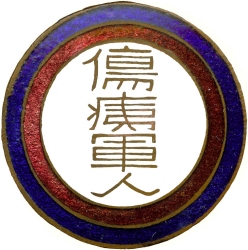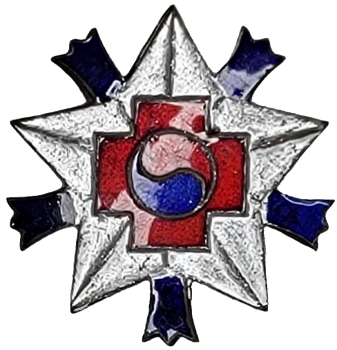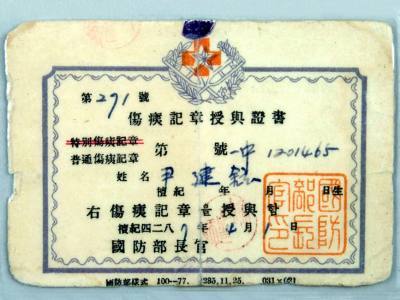Wound Medals 상이군인장 (傷痍軍人章)
1949 SERIES
The end of World War II marked the beginning of the Cold War, and Korea was a strategic point that neither side was willing to concede. On August 15, 1948, the Republic of Korea was established. Less than a month later, on September 9, 1948, the Communists established the “Democratic People’s Republic of Korea” in North Korea.

The newly created Republic of Korea, found itself fighting armed communist guerrillas and insurgents. Several temporary medals and ribbons were created by the military, but very little is known about them. Among these medals was a Wound Medal 陸軍軍人常夷 (육군군인상이장) and a Special Wound Medal for permanent disability 特別常夷軍人 (특별상이군인). As far as can be determined, there is nothing in the official records of the central government, and it is believed that the medals were strictly the property of the South Korean Military. Unfortunately, the records of the Korean Defense Department are inaccessible. At that time, Korea had “Combat Police” which did much of the fighting against insurgents. They probably had access to the same medals.

Shown here to your left, is the only known Special Wound Medal 傷痍軍人章 (상이군인장). Virtually nothing is known about this item. This single example came from the Museum Collection of the American Numismatic Society in New York City. It has a 35.5 mm diameter. On the obverse are the Chinese characters “傷痍 軍人” (상이 군인) literally: Wounded Soldier. The ANS example was mounted on heavy paper and was described as “傷痍軍人章 Awarded to G.I. who is wounded 負傷한 軍人 에게授輿함 (부상한 군인 에게수여함).” The reverse carries a Korean date of 4282.6.15 (Jun. 15, 1949) and a number, but it is unknown if this is a serial number or production number. In Dec. 1949, it was originally donated to the ANS by Major General Edgar Erskine Hume (1889-1952) who was Director General of Medical Services for the U. S. Far East Command under Douglas MacArthur. The ANS sold it at auction on Apr. 26, 2007.
Pictured to the right is the ribbon bar that accompanied the Wound Medal. I do not have pictures of the actual wound medal, but a 1949 newspaper article shows a wound medal, with a ribbon having three stripes. The pendant/badge appears to be the outline of the Korean Peninsula. For pictures of that newspaper article, see my Korea 1945-1950 webpage.
In 1950, the Korean Central Government passed legislation for Wound Medals. In that legislation, they made provisions for a Standard Wound Medal and a Special Wound Medal for Permanent Disability.
1950 SERIES

On Oct. 24, 1950, Korea established two new wound medals by Presidential Decree #389. They are classified as “Wound Medal” and “Special Wound Medal”. For clarity, the Wound Medal is often referred to as the “Standard Wound Medal”.
The (Standard) Wound medal 상이기장 (傷痍記章) has two different suspensions, see the picture below, and comes with possibly three reverses:
- Type 1 – has an area designated for a serial number, and has a serial number. (To date, no wound medals of this type have been observed; however, it has been established that the earlier 1949 wound medals did carry numbers, but it is unknown if they were serial numbers or production numbers.)
- Type 2 – has an area designated for a serial number, but does not have a serial number.
- Type 3 – does not have an area designated for a serial number
The Special Wound Medal 특별상이기장 (特別傷痍記章) is awarded to permanently disabled veterans.

Notice the two different suspensions


Notice the different methods of mounting

